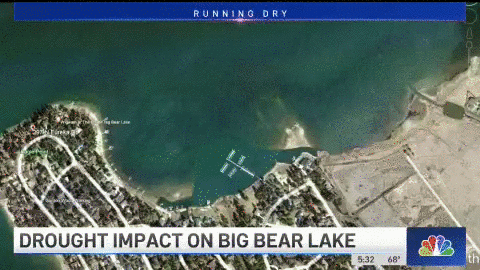Rare summer rainstorms offered some relief this month from the dry spell that has gripped Southern California and the mountain community of Big Bear Lake.
But that rain, courtesy of monsoonal storms, only served to keep the lake level steady. Big Bear Lake remains 16.5 feet below capacity — a dramatic example of the effects of California’s most recent drought.
The last time Big Bear Lake was full was 2011, according to the Big Bear Municipal Water District. There have been some brief highs since then, but mostly lows caused by years of below-normal precipitation in the mountains east of Los Angeles and throughout California.
Get top local stories in Southern California delivered to you every morning. Sign up for NBC LA's News Headlines newsletter.
“Nineteen seventy-seven, 2004, 2018 and then now this year are the four lowest times we’ve had since we started managing the lake and the water,” said Mike Stephenson, water district general manager.
The agency has managed the lake since 1964.
At Boulder Bay Park, the lake has receded so much that boat docks once floating are now resting in dirt. Two years ago, there was plenty of water for kayakers in the popular bay.
Shrinking lake levels are a significant problems for marinas. The lower the water goes, the farther out the docks must be moved so boats can be launched.
Big Bear Marina is now about 300 yards from its original location at the shoreline.
“Logistically, it makes it very difficult for those people coming up the hill to use the lake get on the water in an efficient and quick manner,” Stephenson said.
The Dry Spell's Ripple Effects
Holly Cass owns Summit Real Estate Enterprises Inc. It has been a slow summer for vacation rentals, she said.
"We had a horrible winter, it was very cold and we didn't have any snow,” Cass said. “"It's definitely not just the slowest for us. We are good friends with the bike shops up here and everyone says it's been one of the slowest summers ever.”
Inflation, gas prices and an expanded range of vacation options as the pandemic slows might be factors in the slowdown, but Cass said the lake level is another hit for tourism.
She’s hoping winter brings rains, snow and reason for optimism.
“We need a big winter, very big,” she said.
If winter storms fail to bring significant rain and snow, Stephenson said the community will enter uncharted waters in the months that follow.
"If we get beyond this, we're going to have to get very creative, and we don't know what that is yet because we haven't been there,” Stephenson said.
Drought Conditions in California
The most recent U.S. Drought Monitor report shows the San Bernardino County mountains and most of Southern California in severe drought, the second-most severe category in the weekly report’s four-category drought measurement system.

More than 97 percent of the state is in severe drought. A swath of the Central Valley is in the exceptional drought, the most severe category.
California has spent most of the last 15 years in drought conditions. The current three-year dry spell included one of the driest late winters on record. The state's normal wet season runs from late fall to the end of winter, but dismal precipitation left about 95 percent of California in severe drought at the start of spring with hot and dry summer months ahead.
California recorded its driest first three months of the year on record to start 2022. The dry stretch followed a promising December when storms drenched parts of the state and brought snow to the Sierra Nevada Mountains, California’s natural water reservoir.



